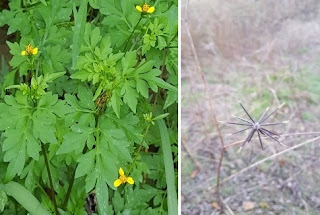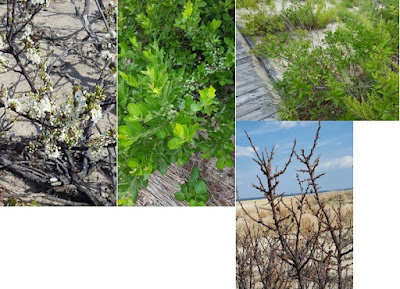"Did you know that
when the temperatures cool in the fall and the leaves are busy
falling off the trees those beautiful field flowers are shriveling up
and turning into plant skeletons? This is actually a term used by
botanists. How about that? Even
nature dresses up for Halloween. Meadows
and open fields are crawling with skeletons in the fall”
(page
20).
You can still have fun
identifying plants after Labor Day during your nature walks at Sandy
Hook. This is a guide to some of the more common plant skeletons you
might notice.
The scientific plant names
above the photos are linked to a great website for identifying plants
in maritime habitats like Sandy Hook, “Cape
May Plants – An Identification
Guide” by CapeMayWildlife.
Since you are staring at
the raw anatomy of a plant without its bloom to distract you, this
post includes the names of the parts of the plants. Except where
noted, all of the technical descriptions of the skeletons are taken
almost verbatim from Carol Levine's 1995 book, “A
Guide to Wildflowers in Winter”.
One-third to one-half of
the plants at the Gateway National Recreation Area aren't
native. If the plant skeleton is “invasive” there will be a
link next to the scientific name to its page in the Invasive
Plant Atlas of the United States. (Invasive plants are empty
calories to the local, native food web, and many are introduced by
what we plant in our yards . This is insightfully explained by Dr.
Doug Tallamy of the University of Delaware during his testimony
on October 2, 2018 to a subcommittee of the Pennsylvania Senate
Agriculture and Rural Affairs Committee (1:09
– 27:30). His “Native
Plant Finder” and Audubon's “Plants
For Birds” webpages offer native alternatives, by zip code, to
the junk ornamentals that are transforming our landscape.)
BAY/OCEAN
White Campion (Silene
latifolia) Invasive.
My favorite because it
looks like Peashooter
in Plants
vs. Zombies. The capsule
is “shiny,
smooth, oval, and one-chambered”. Peashooter's mouth is plain,
while the capsule opening on the white campion is surrounded by “8-10
spreading teeth”.
Common Evening Primrose
(Oenothera
biennis)
Plant skeleton has flower
racemes
“at
the terminal ends of branching stems”. Capsules
are “4-chambered and cylindrical, splitting along the middle of the
chambers”. Seed pod turns woody
on larger plants in the winter.
Beach Wormwood (Artemisia
campestris ssp. caudata)
The
central stem terminates in a panicle
of flower heads that are small beads of achenes.
Sandy Hook has the largest known population of this state-listed
plant in NJ (S2
- Imperiled), according to a 2012
report by
the NJDEP. The second
largest is also in Monmouth County, in the dunes west of the
Keansburg boardwalk.
Common Milkweed (Asclepias
syriaca)
Skeleton follicles
are “warty,
hairy, round at the bottom and pointy at the top, erect on
deflexed
stems”. Monarch
butterfly populations have declined by 90% in the last 20 years,
so the National
Wildlife Federation has been promoting milkweed-planting
throughout the monarch's migratory paths, that
include Sandy Hook. Monarchs will only lay their oval,
off-white eggs (scroll
down) on the underside of the milkweed leaf.
Queen Annes Lace (Daucus
carota) Invasive.
Many-rayed
compound umbels at
the end of the stems. Also known as the wild carrot – its
root smells like one. (Bloom picture from USDA
plant database.)
Knapweed (Centaurea
sp.) Invasive.
Spotted knapweed bloom on
left, tyrol knapweed skeleton on right. “Scraggly,
much branched. Fruits are achenes
widest at the apex, tapered at base. Pappus
has two rows of bristles.”
Skeleton has capsules
“crowded
on a prolonged spikelike raceme.
Capsules are round, 2-parted, splitting along the septum,
with 2 sides or more cleft.” (Bloom picture from USDA
plant database.)
Curly Dock (Rumex
crispus) Invasive.
Skeleton has “straight
brown stalks dense clusters of dried 3-winged heart-shaped sepals
hanging from stems, with a shiny, 3-angled fruit between each sepal
wing.”
Soapwort (Saponaria
officinalis) Invasive.
Bull Thistle (Cirsium
vulgare) Invasive.
"Stems
are conspicuously spiny. Achenes
are elongated, with a pappus
of numerous feathery white hairs”.
Virginia Pepperweed
(Lepidium
virginicum) Invasive.
"Single
stalk or bushy branching, numerous and persistent fruit septa.
Silvery central septum remaining on stem after chambers open.”
Saltwort (Salsola
kali) Invasive.
"Exceedingly
spiny plant of sandy beaches. One-seeded bladdery fruit
(utricle)
enclosed in a 5-lobed calyx.”
Devils Head (Trapa
natans) Invasive.
A seed not a skeleton,
with “four
curved, spike-like “horns” projecting from a knobby hub.”
The picture on the left was taken at Shadow Lake in Middletown of the
“circular
cluster or rosette of leaves, each equipped with an air bladder
along the stem.” “Distinctive
four-pointed seedpods … sink to the bottom of a waterway” and
eventually get washed out into downstream watersheds. The picture on
the left are the seedpods collected from an ocean beach at Sandy Hook
after a Nor'easter.
FRESHWATER WETLANDS
Spanish Needles (Bidens
bipinnata) Invasive.
Swamp Rose Mallow
(Hibiscus
moscheutos)
"Upward
branches few, terminating in 5-chambered capsules
that are round at the summit, sometimes with a short beak.”
Purple Loosestrife
(Lythrum
salicaria) Invasive.
"Four
to six feet high with candelabra branching. Stems terminate in
long fruited spikes. Small, 2-chambered capsules
split along the septum
in whorls. Capsules enclosed by persistent hypanthium.
Fruits disintegrate early, leaving stubs and stalks.” (Skeleton
picture from here)
Seedbox (Ludwigia
alternifolia)
"Fruit capsules
are square
boxes with persistent sepals.”
One siting
at Sandy Hook, in the freshwater wetlands across from Guardian
Park.
FORT HANCOCK
Yucca (Yucca
filamentosa)
"Fruit
remnants are in branched racemes
raised far above leaves on tall stems. Basal
leaves are thick, rigid and ascending (spreading
horizontally, then becoming erect), with loose twisting threads
on margins.”
Japanese Knotweed
(Reynoutria
japonica) Invasive.
"Grows
in large, dense clumps. Stems arch out while fruit stalks zig-zag
upward. Fruit falls early and leaves small stems.” This paper
from Pennsylvania shows just how thoroughly Japanese Knotweed
takes out native species: “Our results suggest that F. japonica
has reduced the diversity and abundance of native understory riparian
plant species. The species also appears to have suppressed long-term
tree recruitment, setting up a trajectory whereby the eventual
decline of trees currently in the canopy could shift this community
from a tree-dominated riparian forest to a knotweed-dominated
herbaceous shrubland.”
Jimsonweed (Datura
stramonium) Invasive.
"Fruits
are erect, spiny capsules on short stems in branching axils.
Fruits are 4-chambered, opening in 4 parts longitudinally by the
valves (part
of the fruit wall). The calyx
leaves a collar under the fruit.”
False Indigo (Amorpha
fruticosa) Invasive.
"Pods
are black oval-elliptic, ascending (spreading
horizontally, then becoming erect) or divergent (spreading
in different directions), and narrowed below a thick stem and
above to a curved beak.” Small,
"warty, kidney-shaped pod is persistent into winter”.
Common Lilac (Syringa
vulgaris) Invasive.
Skeletons have “dense
terminal panicles,
with loose clusters
of smooth, brown, flattened, dehiscent
seed capsules.”
NEXT STEPS
You can zoom-in to Sandy
Hook to see a map of these pictures –as well as over 14 million
observations worldwide - that have been geolocated and posted at
iNaturalist.org.
If you are into winter ID
here are 2 excellent references:
Levine, Carol. 1995. A
Guide to Wildflowers in Winter: Herbaceous Plants of Northeastern
America. Yale University Press, New Haven and London.
Wojtech, Michael, 2011.
Bark:
A Field Guide to Trees of the Northeast. University Press of New
England, Lebanon, NH.
















































